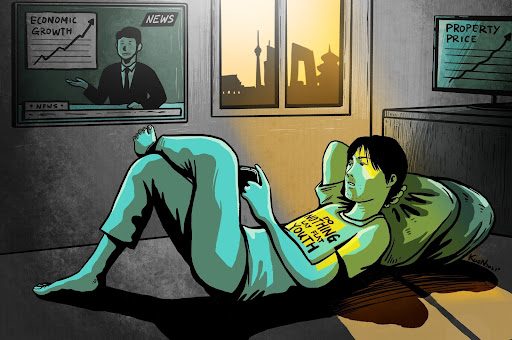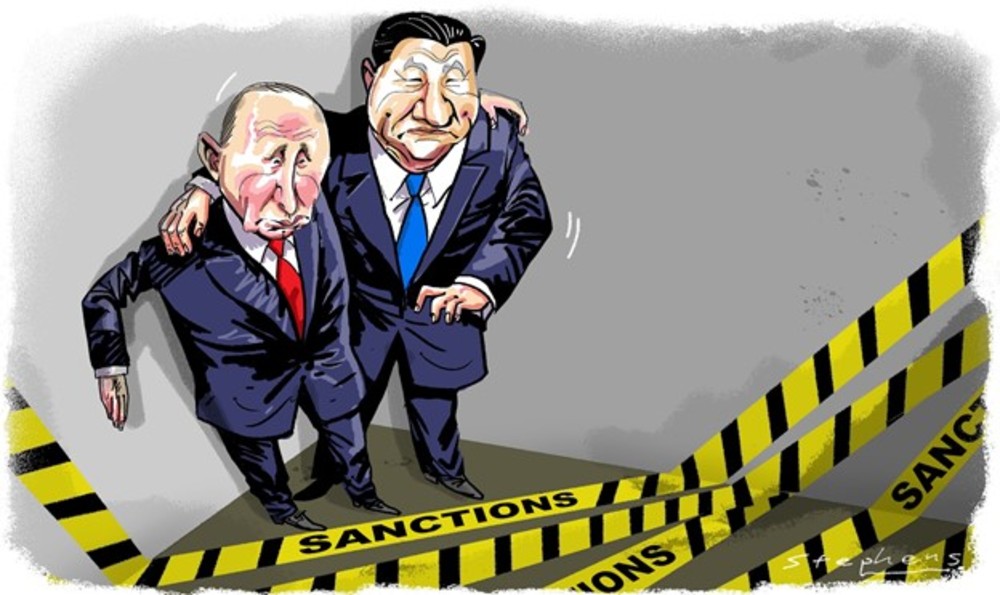
DIMA ZAYARUZNY AND KIET HOA – NOVEMBER 14, 2023
In the dynamic landscape of contemporary China, a striking economic and social phenomenon has gained prominence—”lying flat”. This intriguing trend speaks to a growing segment of the population’s deliberate choice to opt out of the pursuit of traditional economic success, such as high-stress careers and unrelenting work hours. In an economy shaped by historic pressures like the Imperial examination system and the modern-day “996” work culture (9 AM-9 PM, 6 days a week), this phenomenon holds significant implications for China’s employment statistics and economic trajectory. This article will explore “lying flat” in China, its origins, its connections to historical pressures, and its potential impact on the country’s economic landscape and labor market.
How It All Came to Be
Firstly, it is important to understand the historical background of meritocracy and academic excellence that protrudes through all facets of modern Chinese culture. China’s Imperial Examination System and the profound pressure to excel within it have left a lasting imprint on the country’s cultural identity. This system, spanning over a millennium, was designed to select government officials based on their mastery of Confucian classics and administrative abilities. Intense competition, societal expectations, and an unrelenting emphasis on academic excellence marked the pursuit of success in these exams. This historical legacy laid the foundation for the contemporary pressures faced by Chinese youth in areas such as education, careers, and personal well-being, setting the stage for the emergence of “lying flat” as a response to these pressures.
The movement first arose when a man, in his mid-twenties, posted on social media about his embrace of a “no desire lifestyle” and his decision to spend two years enjoying life by remaining unemployed and pursuing his hobbies. This post went viral all around China, with many choosing to follow this lifestyle but, like many other viral sensations in China, was quickly taken down by CCP censorship. The phrase 躺平 (tang ping) or “lying flat” quickly got banned on all Chinese internet sites.
“Lying Flat” and its Relationship to Macroeconomics
The movement gained traction due to China’s economic slowdown post-Covid and the end of its “growth miracle” in the 90s and 2000s; these factors greatly impacted young people’s perception of the job market and their future prospects. Young adults in the job market are not able to find jobs as easily as their parents had 20-30 years prior and are discouraged by the struggles they are facing. Furthermore, in June of 2023, 11.6 million new graduates entered China’s workforce, a number unimaginable in any other country. In fact, youth unemployment has become so bad (over 20%) that the government has stopped posting the statistics.
China’s domestic policies are currently undergoing significant shifts, with several interconnected issues at play that exacerbate unemployment. The intense societal pressure to excel academically and professionally has long been a hallmark of Chinese culture, resulting in the youth being shamed for not working hard or underperforming in school. Consequently, young workers are burnt out by this pressure and are unsatisfied with their careers and their professional lives. Concurrently, the Chinese government is implementing policies to divert talent from the private tutoring, property, tech, and finance industries and move them towards sectors it deems essential for the nation’s advancement, particularly information technology and advanced manufacturing. Therefore, many are forced into fields they have no interest in and are discontent with their role, perhaps, pushing them to empathize with the “lying flat” movement. This redirection of resources may have far-reaching consequences on China’s economic landscape, as discontent workers are notoriously less productive. Specifically, Forbes reports that “disengaged employees are 15 percent less profitable and 18 percent less productive than those who are satisfied with their jobs”. Meanwhile, an increasing number of intellectuals and highly educated individuals are choosing to emigrate, seeking places with more academic freedom, reduced work demands, and a more balanced lifestyle. This trend, combined with the fact that the Chinese education system does not always produce workers suitable for various industries, contributes to frictional unemployment; where workers’ skills and opportunities are not well-matched, posing a complex challenge for the country’s labor market.
In tandem with “laying flat” and frictional unemployment, China’s struggles on the global stage could be detrimental to its economy. Individuals opting out of high-stress careers can lead to a less efficient allocation of human capital, potentially resulting in higher unemployment rates and reduced economic output. Moreover, the delayed reopening from Covid restrictions and the ongoing global trade slump have contributed to economic stagnation, posing significant hurdles to recovery. In addition, worsening relations with the United States have amplified geopolitical tensions, leading to decreased foreign investment in Chinese bonds, companies, and currency. The perception of China’s economic reliability has been called into question, further discouraging international investors. Collectively, these economic challenges and uncertainties are reshaping China’s role in the global economy, making it imperative for the nation to address its domestic issues while navigating its external relationships to regain trust and overall stability in the international economic arena.
In conclusion, the complex web of challenges facing China’s economy today underscores the urgent need for comprehensive solutions. From the pressures driving individuals to “lay flat” to the government’s redirection of talent and the exodus of highly educated professionals, these issues have rippling effects across society and the global economic landscape. To address these challenges effectively, China must prioritize the well-being of its workforce and recognize that workers are the backbone of production and output. Ensuring a balanced work-life environment, offering opportunities for personal growth, and fostering a culture that values individuals beyond their economic contributions are essential. Furthermore, policy adjustments should aim to strike a harmonious balance between companies’ needs and workers’ well-being, acknowledging that a healthy and motivated workforce is the cornerstone of sustainable economic growth. China has become famous for its unbelievably successful transitional market reforms; unfortunately, today’s government has stalled and reverted slightly towards a more planned economy. Reform and Opening Up has been China’s strength since the 80s, and they must continue to find ways to develop further. By addressing these issues holistically, China can pave the way for a more stable and prosperous future domestically and on the world stage.
Featured Image Source: South China Morning Post
Disclaimer: The views published in this journal are those of the individual authors or speakers and do not necessarily reflect the position or policy of Berkeley Economic Review staff, the Undergraduate Economics Association, the UC Berkeley Economics Department and faculty, or the University of California, Berkeley in general.


